A nurse administers a COVID-19 test or a phlebotomist draws blood for other testing and then patients wait for potentially life-changing results — never seeing the army of medical laboratory scientists whose work can give them hope or decide their treatment.
Texas Health’s already-busy laboratories — behind locked doors, frequently in the hospital basement, quiet havens for analytical minds and complex instruments — exploded into action at breakneck speed as the pandemic began to rage across North Texas.
They couldn’t stop to take a breath — then or now, with COVID-19 cases increasing.
“We haven’t come out of it,” said Jan Howard, MT(ASCP) SM, lab director at Texas Health Presbyterian Hospital Dallas. Besides the ongoing spread of COVID-19 today, flu season is around the corner. “We are already pre-planning for the fall, making sure we’re as prepared as we can be.”
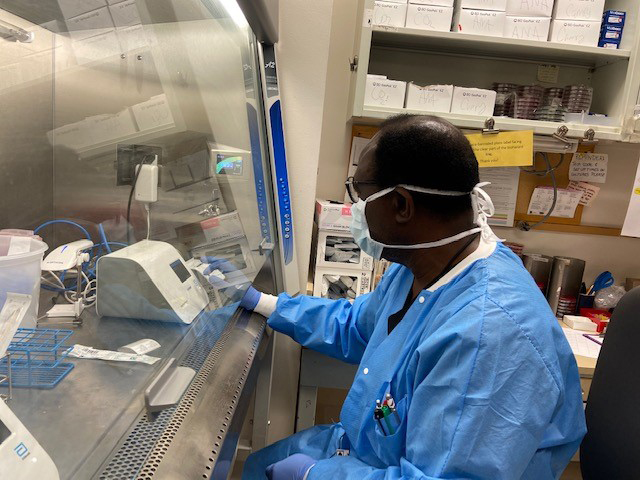
Unknowns in the early months
The early months were challenging for Texas Health’s labs as never before.
“We had a lot of patients and we had a lot of unknowns,” said Michael Crockett, MT (ASCP), lab director at Texas Health Harris Methodist Hospital Hurst-Euless-Bedford. “Flu season was supposed to be ending, and we were saying ‘Is this the back end of the flu? Is it COVID?’ We didn’t know then how infectious it is. Everybody was in the unknown period.”
Unsung heroes began to proliferate — from techs and scientists who deftly juggled training on new instruments in record time to clinical lab assistants working in the Emergency Departments.
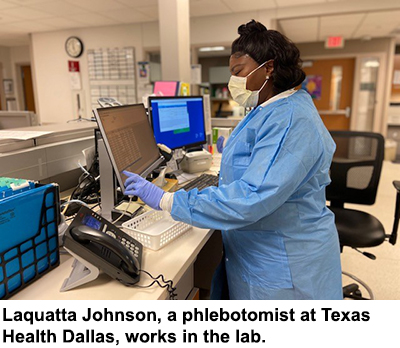
Phlebotomists at the hospitals really began to shine. They enter rooms with COVID-19 positive patients and persons under investigation to draw blood, as well as collecting blood from all the other patients when needed.
“Some of the unsung heroes are our phlebotomists,” said Alicia Rizzo, MSHM, LSSBB, MT (ASCP), lab director at Texas Heath Harris Methodist Hospital Alliance. “They’re going into the patient rooms all day, without knowing what they are walking into. Their strength and purpose really shone through the chaos.”
Jan agreed. “Our phlebotomy has been absolutely incredible.”
Collaboration between lab directors and other clinicians, already strong, immediately became more intense.
“We had collaborative conversations with physicians, nursing and executives,” Alicia said. “We were the artery of this whole process, but we would not have been successful without the nurses’ collaboration.”
Going into hyperdrive
At first, the problems included lack of a speedy test and availability of test kits.
A key player at Texas Health HEB was lead lab tech Cinnamon Uptmoor, MT (ASCP), Michael said, because of a contact at the Tarrant County Health Department. Cinnamon said she’d gone to school at the University of Texas Galveston Medical Branch with a friend who was now working in bioterrorism at the health department.
They quickly connected and Texas Health HEB was able to get positive and negative samples they needed for testing validation. Before a lab can begin using a new testing platform, their test results must match those of a reference lab.
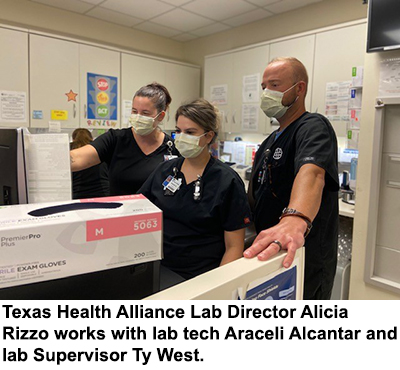
Texas Health Dallas’ lab has had a longstanding relationship with Dallas County since the Ebola event in 2014, said Laura Knoll, M.S., M.A., MT (ASCP) MB (ASCP)CM, manager of the special procedures lab. She said that experience also helped the labs quickly prepare test kits for nurses to use with patients, complete with instructions.
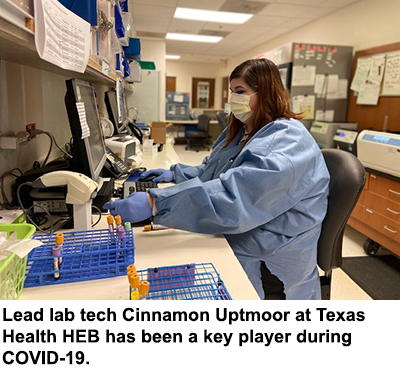
By early April, when the rapid ID Now test became available, Texas Health Dallas’ lab went into hyperdrive.
“We brought it up in one day,” Laura said. “That’s unheard-of. Depending on the test it could take a month or more, typically.”
Alicia credits lab supervisor Ty West, MLS (ASCP) CM, with taking all the steps to get ID Now testing done at Texas Health Alliance in two days.
“He did a phenomenal job on that,” she said. “His focus, drive and strong leadership were key to our success.
Hub Labs
At Texas Health Dallas, ID Now makes up only a small portion of COVID-19 tests, Laura said. New equipment has been purchased so the lab can quickly run other, more sensitive tests.
Texas Health has two hub labs, one at Texas Health Dallas and the other at Texas Health Harris Methodist Hospital Fort Worth. They can take on testing that can’t be done in-house at other hospitals. Hospitals that don’t have in-house capabilities for some tests can send specimens to the hub labs and the two hubs also share testing depending on which instrument and training is need.
Texas Health Dallas’ lab has about 144 people, divided into different departments: core lab, special procedures/ microbiology, lab administration, blood bank and anatomic pathology.
“Virtually everybody in every department has been impacted by the COVID testing or collecting, or packaging of the collection kits,” Jan said. “It’s been a team effort.”
Systemwide collaboration
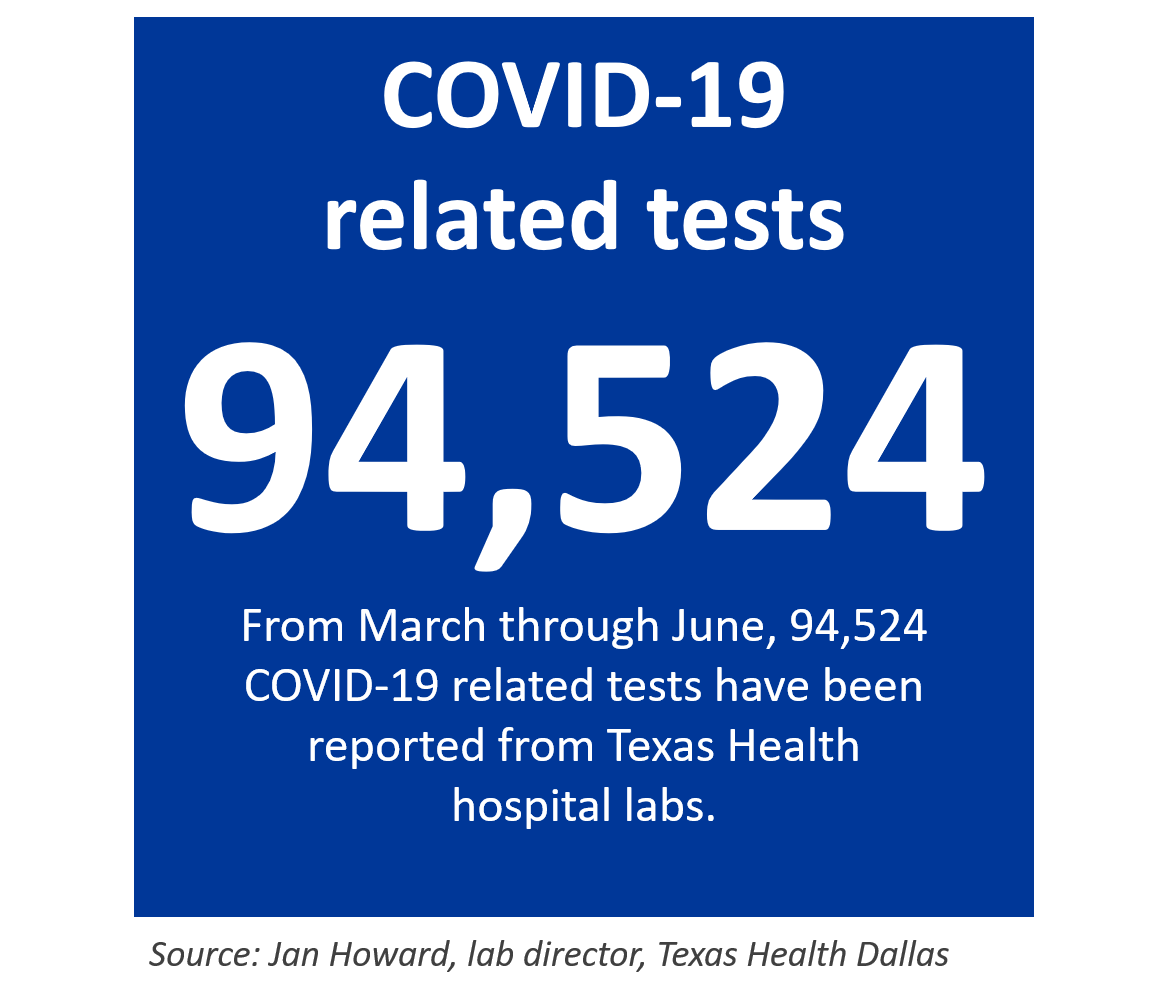
“The tenacity and speed with which our labs have supported our patients and caregivers is nothing short of heroic,” said Kirk King, executive vice president and hospital channel chief operating officer. “While patients will never see most of their faces, the lab team plays such a critical role in patient flow and experience. From experienced phlebotomists taking blood to those running the tests, they provide a vital service for our hospitals.”

Lab services and bringing online a wide range of testing options has been a high priority for system leaders throughout the pandemic.
All three lab directors said the support of Texas Health Resources as a system has been invaluable.
“I think Texas Health is really strong in the lab science area because of the amount of collaboration that happens with all the directors and teams,” said Michael. “We work together to keep each other abreast of any changes.”
At Texas Health Dallas, the contribution of the lab’s medical director, Beverly Dickson, M.D., has been crucial, Jan said. “She’s been a key person working around the clock since day one. And Texas Health has done an amazing job to support us with equipment and resources.”
Long hours and mutual support across the system have paid off, Alicia said: “Everybody has worked as hard as they can. This is a shining example of what you can do when people collaborate and all come together to meet a common goal.”
(Pictured top right: John Okuzor, MT (ASCP), a lab scientist at Texas Health HEB, performs an ID Now COVID-19 test.)
By Judy Wiley • Posted July 14, 2020

